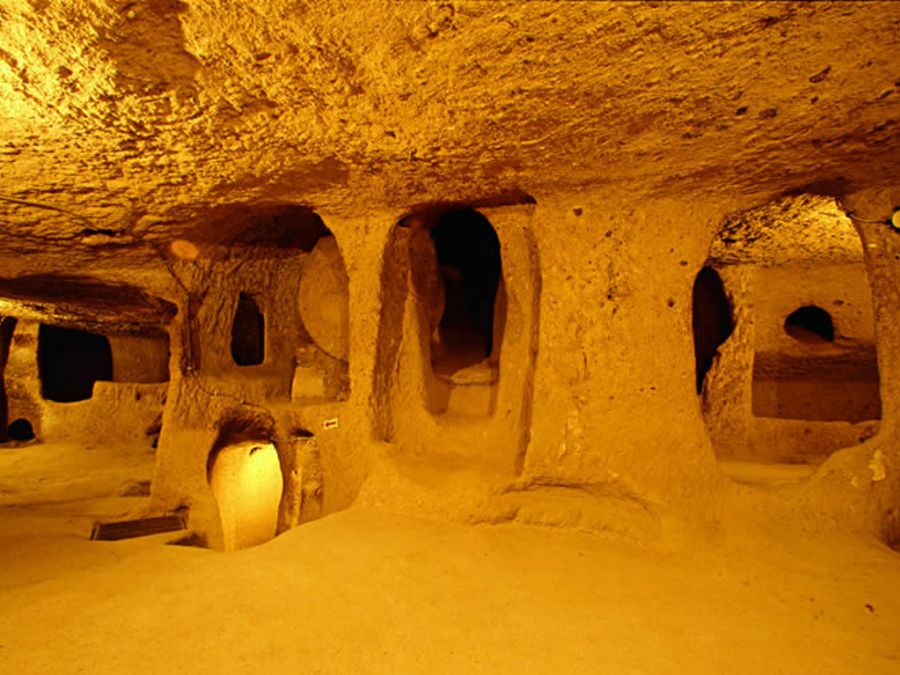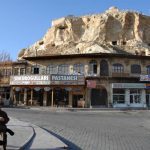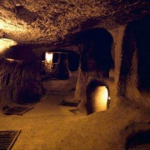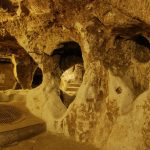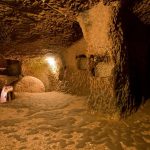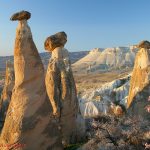The Hittites And The Phrygians in Derinkuyu region of Cappadocia,
The Hittite state was established by Labarnash in the XX century B.C. and this central Asian race established in Anatolia in 1900-1200 B.C. as one of the greatest civilizations of the Middle East. Hattushash was their capital. They soon were strong enough to invade Syria and put an end to the Hammurabi’s dynasty. After that, Mesopotamian art stagnated owing to the successive invasions and old traditions barely survived within their respective original territories. Approximately in the XVII century B.C, we witness a new invasion of Asia Minor by races coming from the north. Some of these conquered those who had overthrown Hammurabi’s dynasty and became the rulers of Mesopotamia; the territories of others extended from the Persian Gulf to the Black Sea.
From certain artifacts discovered in the Derinkuyu region, we understand that some of these tribes settled in this region, and realized the important place occupied by Asia Minor in early civilizations. However, it is obvious that the Hittite civilization was inferior in the fields or architecture and sculpture to Egypt and Mesopotamia. It remained static from the bronze age onwards. During the time of the Great Empire, the Hittites used button shaped seals and their discovery by local inhabitants digging foundations nowadays is proof of Hittite occupancy of Derinkuyu. After the collapse of the Hittite Empire also Hittite culture ceased to exist. Excavations reveal that specimens of Hittite culture were covered by the ashes of a great fire. The Greeks, for instance, were unaware of the existence of the Hittites, as we can see from Herodotus’travel diary. From 1200-800 nothing has survived in Anatolia of Hittite art. This fact has led archeologists to conclude that between those dates very few people lived in Anatolia and cities were rarely found. This means that the races who overcame the Hittites razed the whole region and massacred the population. There was no sign of life in Anatolia for a long time. This complete destruction was such that 800 years after it, even Herodotus (484-424 B.C.) could tell us nothing about the Hittites.
Scholars suppose the Phrygians to be the people who destroyed the Hittite Empire. It is supposed that it was they who so effectively razed the Central Anatolian plateau; so thorough was this destruction that none of the buildings to be found in Derinkuyu today is older than five hundred years. The existence of very ancient foundations discovered when foundations are dug today indicates that the Hittite civilization that flourished at Derinkuyu was put to an end in 1200 B.C. by waves of invaders that came from Thrace. Professor Ekrem Akurgal in his “Die Kunst der Hittites” states that the civilization and the peaceful life of Anatolia were disrupted and brought to a violent end by the invasion in 2000 B.C. of a ruthless race.
Over the remnants of the strata of this age in Hattushah (Alacahoyuk, Bogazkoy) lie the traces of a fire. The signs of similar fires are also seen in other cities of that age, such as Karaoglan, Dundartepe and Karahoyuk in Konya. It is clear from these fires that the above-mentioned invasion extended over the whole of Central Anatolia. But Derinkuyu is an exception; no layer. indicating a fire has been discovered here. Though no exhaustive research has been made here on this subject, it may be assumed that the Hittites used the usual storage rooms on the first floor as places of refuge during the massacres. In Derinkuyu there are water storage tanks and flour mills carved into the hard rock. The capacity of one water tank is 30.000 liters. Hittitologists consider this race of Indo-European origin; there is evidence that the Hittites settled in South and Central Anatolia in 2000 B.C. We have no proof today that the Phrygians ever lived at Derinkuyu; only an extensive study of the region could provide a definite answer to this question. But certain signs might be interpreted to show that they did settle in the vicinity of Derinkuyu. Such a place is to the south of Gilder village, at a distance of 4 km. from Derinkuyu, where villagers excavate Phrygian artifacts.

